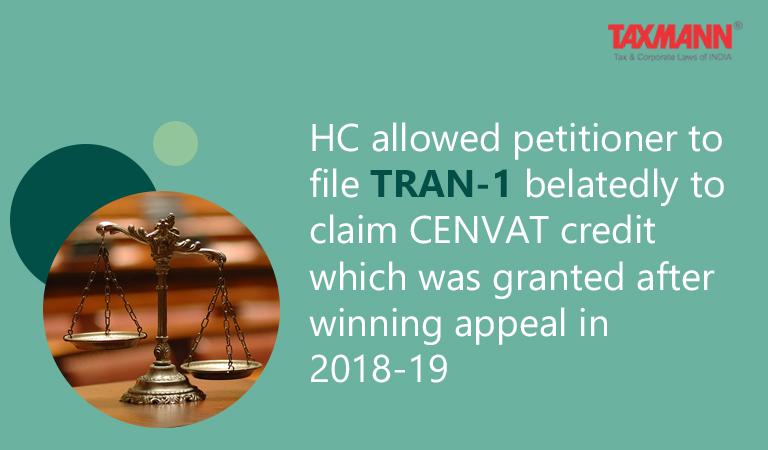HC allowed petitioner to file TRAN-1 belatedly to claim CENVAT credit which was granted after winning appeal in 2018-19
- Blog|News|GST & Customs|
- 3 Min Read
- By Taxmann
- |
- Last Updated on 11 August, 2021
Case details: Jahanpanah Club v. Union of India - [2021] 129 taxmann.com 10 (Delhi)
Judiciary and Counsel Details
-
- Manmohan and Sanjeev Narula, JJ.
- Sumit K. Batra and Manish Khurana, Advs. for the Petitioner.
- Amit Bansal, Sr. Standing Counsel and Ms. Vipasha Mishra for the Respondent.
Facts of the Case
The petitioner was issued show cause notices raising service tax demands on their operations/services. Due to lack of knowledge, CENVAT was not availed for the years 2012-13 to 2017-18 and the Adjudicating Authority permitted the petitioner to avail ITC for 2015-16 to 2017-18 only and rejected claim for previous years. However, it approached this Court and filed writ petition with contention that without order, on the merits mere rejection cannot be appealed. The Court directed to complete the proceedings and pass a reasoned order. The detailed order was passed rejecting the claim and it filed appeal.
On filing appeal against the order, it requested the CESTAT to allow adjustment against the CENVAT credit for payment of pre-deposit. But an objection was raised that the CENVAT credit was not carried forward from service tax to GST regime through the GST TRAN-1 form and since TRAN-1 Form was not filed, the entire amount of CENVAT credit will become redundant. It again filed this writ petition before the Court.
High Court Held
The Honorable High Court observed that the CENVAT credit was granted pursuant to the order passed by the Commissioner dated 5th October, 2018 and the order dated 8th May, 2019 passed by the Commissioner (Appeals), which is after the appointed date of July, 2017 when the GST regime came into force. The petitioner could not file Form TRAN-1 as the last date of filing the claim for credit expired on 27th December, 2017. Since, the delay in filing TRAN-1 Form could not be attributed to petitioner, the petitioner could not lose its vested right over accumulated CENVAT credit and, therefore, the department was directed to either open portal so as to enable petitioner to file TRAN-1 Form electronically or to accept a manually filed TRAN-1 Form.
Case Review
-
- Bhargava Motors v. Union of India [2019] 106 taxmann.com 200 (Delhi) (para 7)
- Blue Bird Pure (P.) Ltd. v. Union of India [2019] 108 taxmann.com 218/75 GST 59 (Delhi) (Mag.) (para 7)
- Krish Automotors (P.) Ltd. v. Union of India [2019] 110 taxmann.com 266/76 GST 805 (Delhi) (para 7) followed.
- JCB India Ltd. v. Union of India [2018] 92 taxmann.com 131/67 GST 52 (Bom.) (para 8) distinguished.
List of Cases Referred to
-
- Willowood Chemicals (P.) Ltd. v. Union of India [2018] 98 taxmann.com 100 (Guj.) (para 6)
- JCB India Ltd. v. Union of India [2018] 92 taxmann.com 131/67 GST 52 (Bom.) (para 6)
- JCB India Ltd. v. Union of India [SLP (C) No. 30204 of 2018] (para 6)
- Brand Equity Treaties Ltd. v. Union of India [2020] 116 taxmann.com 415 (Delhi) (para 7)
- Union of India v. Brand Equity Treaties Ltd. [2020] 117 taxmann.com 225 (SC) (para 7)
- Bhargava Motors v. Union of India [2019] 106 taxmann.com 200 (Delhi) (para 7)
- Union of India v. Bhargava Motors [Diary No. 38404 of 2019] (para 7)
- Blue Bird Pure (P.) Ltd. v. Union of India [2019] 108 taxmann.com 218/75 GST 59 (Delhi) (Mag.) (para 7)
- Union of India v. Blue Bird Pure (P.) Ltd. [SLP (C) No. 4916 of 2020] (para 7)
- Krish Automotors (P.) Ltd. v. Union of India [2019] 110 taxmann.com 266/76 GST 805 (Delhi) (para 7)
- Department of Trade & Taxes v. Krish Automotors (P.) Ltd. [Diary No. 5317 of 2020] (para 7)
- Union of India v. Krish Automotors (P.) Ltd. [SLP (C) No. 6337 of 2020] (para 7)
- Filco Trade Centre (P.) Ltd. v. Union of India [2018] 97 taxmann.com 314/69 GST 532 (Guj.) (para 8)
- Union of India v. Filco Trade Centre (P.) Ltd. [2019] 104 taxmann.com 187 (SC)(para 8).
Disclaimer: The content/information published on the website is only for general information of the user and shall not be construed as legal advice. While the Taxmann has exercised reasonable efforts to ensure the veracity of information/content published, Taxmann shall be under no liability in any manner whatsoever for incorrect information, if any.

Taxmann Publications has a dedicated in-house Research & Editorial Team. This team consists of a team of Chartered Accountants, Company Secretaries, and Lawyers. This team works under the guidance and supervision of editor-in-chief Mr Rakesh Bhargava.
The Research and Editorial Team is responsible for developing reliable and accurate content for the readers. The team follows the six-sigma approach to achieve the benchmark of zero error in its publications and research platforms. The team ensures that the following publication guidelines are thoroughly followed while developing the content:
- The statutory material is obtained only from the authorized and reliable sources
- All the latest developments in the judicial and legislative fields are covered
- Prepare the analytical write-ups on current, controversial, and important issues to help the readers to understand the concept and its implications
- Every content published by Taxmann is complete, accurate and lucid
- All evidence-based statements are supported with proper reference to Section, Circular No., Notification No. or citations
- The golden rules of grammar, style and consistency are thoroughly followed
- Font and size that’s easy to read and remain consistent across all imprint and digital publications are applied








 CA | CS | CMA
CA | CS | CMA


